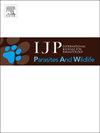Sarcoptic mange in a guanaco (Lama guanicoe) of northwestern Argentina: Clinical, histopathological and molecular studies
IF 2
3区 医学
Q3 ECOLOGY
International Journal for Parasitology-Parasites and Wildlife
Pub Date : 2025-03-26
DOI:10.1016/j.ijppaw.2025.101062
引用次数: 0
Abstract
Sarcoptic mange, caused by the mite Sarcoptes scabiei, is a highly contagious and potentially fatal skin disease that affects a wide range of mammals, including South American Camelids (SAC). Although the presence of mange has been described in vicuñas and llamas in northwestern Argentina, there are no previous records documenting its presence in guanacos (Lama guanicoe) of this region. We here describe a case of S. scabiei in a free-ranging guanaco in the Department of Tilcara, Jujuy Province. The animal presented alopecic, erythematous and hyperkeratotic lesions with abundant crusts in the ventral region of the body and limbs. Histopathology revealed periadnexal dermatitis with inflammatory infiltrate, severe hyperemia, orthokeratotic and parakeratotic epidermal hyperplasia, and stratum corneum thickening. The etiological agent was identified as S. scabiei by microscopic examination of adult mites. This result was confirmed by sequencing of a cytochrome oxidase subunit I gene fragment, that showed 100 % identity with sequences of isolates from SAC and other mammals. Genotyping of three mites isolated from different parts of the guanaco's body using a set of ten microsatellite markers indicated the infection with a single genetic variant that showed a similar profile to those found in S. scabiei isolates from vicuñas and llamas of the same region. However, genetic differences with guanaco isolates from midwestern Argentina were observed. This work presents the first record of sarcoptic mange in a guanaco in Jujuy Province and in the northwestern region of Argentina, as well as the molecular characterization of the etiological agent. The case highlights an uncertain scenario regarding the health situation of the guanaco population in this region, which is small, fragmented, and locally categorized as endangered. Epidemiological surveillance programs for guanacos and further research on the impact of sarcoptic mange on the conservation of this species are needed.

阿根廷西北部瓜纳科(Lama guanicoe)的结节病:临床、组织病理学和分子研究
疥疮性疥疮是由疥螨引起的,是一种高度传染性和潜在致命的皮肤病,影响广泛的哺乳动物,包括南美骆驼(SAC)。虽然在阿根廷西北部的vicuñas和大羊驼中描述了管理的存在,但在该地区的瓜纳科斯(Lama guanicoe)中没有先前的记录记录它的存在。我们在这里描述了一个在胡胡伊省蒂尔卡拉省的自由放养的瓜纳科动物的病例。动物表现为斑秃,红斑和角化过度病变,在身体和四肢的腹侧区域有大量的痂。组织病理学显示:附件周皮炎伴炎性浸润,严重充血,角化和角化不全表皮增生,角质层增厚。经成虫显微镜检查,病原鉴定为疥螨。细胞色素氧化酶亚基I基因片段的测序结果证实了这一结果,该片段与SAC和其他哺乳动物分离物的序列100%一致。利用一组10个微卫星标记对从瓜纳科动物身体不同部位分离的3种螨进行基因分型,结果表明该感染具有单一遗传变异,其特征与从vicuñas和同一地区的骆驼分离的疥螨相似。然而,与阿根廷中西部的瓜纳瓜分离株存在遗传差异。本文首次报道了阿根廷胡胡伊省和西北地区瓜纳科动物的肉毒杆菌病,并对其病原进行了分子鉴定。该案例凸显了该地区瓜纳科种群健康状况的不确定性,该地区瓜纳科种群数量少、分散,在当地被列为濒危物种。需要开展瓜纳科斯的流行病学监测计划,并进一步研究管理对该物种保护的影响。
本文章由计算机程序翻译,如有差异,请以英文原文为准。
求助全文
约1分钟内获得全文
求助全文
来源期刊

International Journal for Parasitology-Parasites and Wildlife
Medicine-Infectious Diseases
CiteScore
3.80
自引率
5.60%
发文量
113
审稿时长
45 days
期刊介绍:
The International Journal for Parasitology: Parasites and Wildlife (IJP-PAW) publishes the results of original research on parasites of all wildlife, invertebrate and vertebrate. This includes free-ranging, wild populations, as well as captive wildlife, semi-domesticated species (e.g. reindeer) and farmed populations of recently domesticated or wild-captured species (e.g. cultured fishes). Articles on all aspects of wildlife parasitology are welcomed including taxonomy, biodiversity and distribution, ecology and epidemiology, population biology and host-parasite relationships. The impact of parasites on the health and conservation of wildlife is seen as an important area covered by the journal especially the potential role of environmental factors, for example climate. Also important to the journal is ''one health'' and the nature of interactions between wildlife, people and domestic animals, including disease emergence and zoonoses.
 求助内容:
求助内容: 应助结果提醒方式:
应助结果提醒方式:


